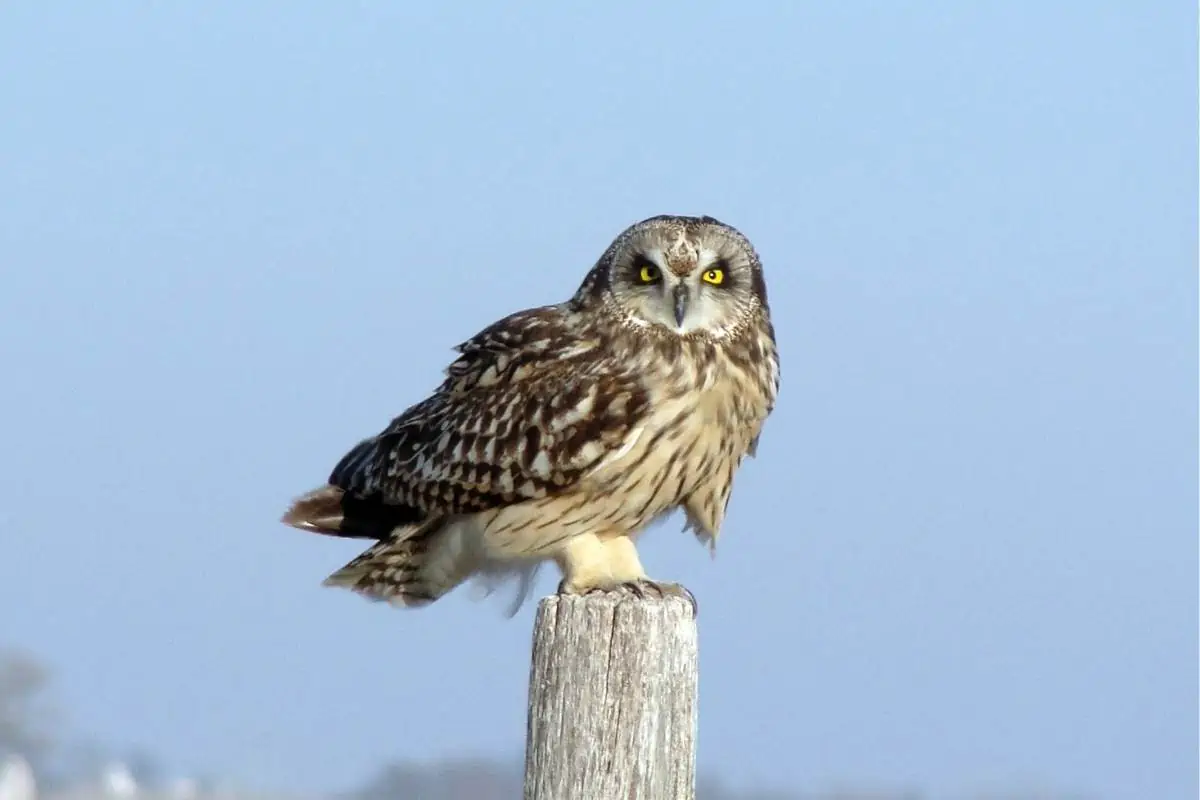Many people like the enigmatic owl. Their camouflage and nocturnal habits make them all the more interesting since we seldom get to see them. You may also be curious about how many varied species of owls can be discovered in my region? We will look at eight different species of owls in New Jersey in this article.
8 OWLS IN NEW JERSEY
The barn owl, barred owl, eastern screech owl, great-horned owl, long-eared Owl, northern saw-whet Owl, and short-eared Owl are the eight species of owls found in New Jersey.
From woodlands to the coast, New Jersey offers a variety of habitats for owls. Several documented owl sightings seem to take place along the state’s coasts, as I’ve learned. The more difficult to locate owls on this list are likely to be found here:
- Forsythe Wildlife Refuge Brigantine
- Sandy Hook
- Manahawkin Wildlife Management Area
- Cape May Wetlands State Natural Area
- Fortescue Wildlife Management Area
- Natural Lands’ Glades Wildlife Refuge
1. BARN OWL
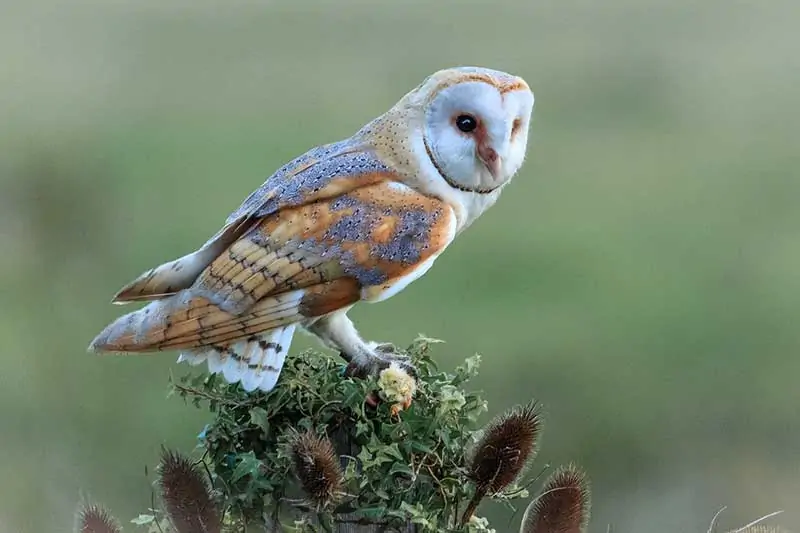
- Scientific name: Tyto alba
- Length: 12.6 – 15.8 in
- Wingspan: 39.4 – 49.2 in
- Weight: 14.1 – 24.7 oz
While they may be challenging to locate, barn owls can be found all year in New Jersey. Grasslands, fields, ranches, agricultural land, and strips of forest are their preferred open habitats.
Barn owls prefer to build nests in barns, attics, and church steeples, among other man-made structures with a lot of eaves and beams. It’s likely how they earned their moniker. Tree holes, caverns, and cliff ledges are also used as nests. During the day, Barn Owls are very nocturnal and are difficult to spot.
They fly low over fields at dusk and through the night, using their exceptional hearing to detect mice and other rodents. If you catch a glimpse of them in low light, their huge, ghostly white face and belly may give you a creepy impression!
2. BARRED OWL

- Scientific name: Strix varia
- Length: 16.9 – 19.7 in
- Wingspan: 39.0 – 43.3 in
- Weight: 16.6 – 37.0 oz
Throughout New Jersey, the exquisite brown and white striped barred owl may be found all year. These birds prefer to stay within a 10-mile radius of their nests, even if they aren’t always visible.
They don’t like to be in the same region as the great horned owl, despite their similar range. Barred owl eggs, young birds, and even adults are all targets for great horned owls.
When there are vast stretches of uninterrupted woodland, barred owls favor mixed and mature trees near water. On a hiking trip, you may occasionally sight them roosting in trees. While hunting, they are most active at night.
Their distinct hooting cry is likened to “who cooks for you?” in terms of volume and tone. “Who prepares your meals?” A mated pair will sing a variety of hoots, honks, caws, and gurgles throughout the course of their courtship.
3. EASTERN SCREECH-OWL

- Scientific name: Megascops asio
- Length: 6.3 – 9.8 in
- Wingspan: 18.9 – 24.0 in
- Weight: 4.3 – 8.6 oz
Throughout most of the eastern United States, including New Jersey, this little owl can be found year-round.
Gray, brown, or “red” (really a reddish brown) are the three plumage tones of northern screech owls. The patterns on their feathers, whether they’re white or black, are ideal for blending in with tree bark.
Their name may hint that they emit a shrill or terrifying noise, but this is not the case. They make trilling noises or “whinnies” that resemble a high-pitched horse, rather than hooting.
Eastern screech owls will come to your yard if you install an appropriately sized nest box. Farmland, city parks, and suburban communities are all home to these small owls. Almost any location with trees has some form of cover.
4. GREAT HORNED OWL
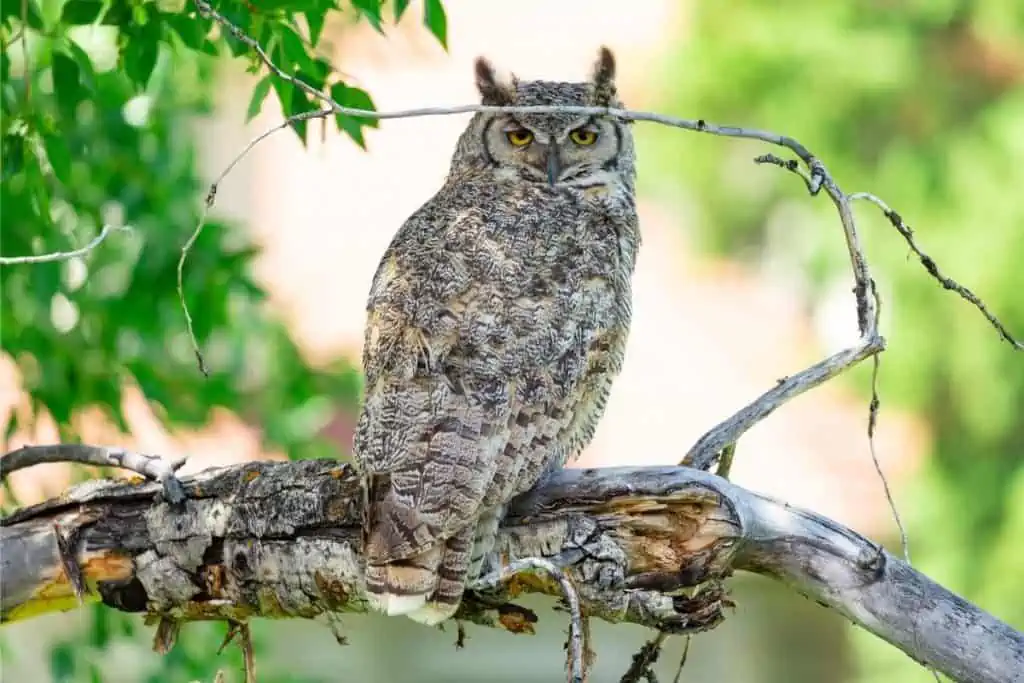
- Scientific name: Bubo virginianus
- Length: 18.1 – 24.8 in
- Wingspan: 39.8 – 57.1 in
- Weight: 32.1 – 88.2 oz
Due to their large size, yellow eyes, and “horns” that are tufts of feathers that protrude out on either side of their head, great horned owls are one of the most common and identifiable owls in North America.
Forests, swamps, deserts, and urban settings such as city parks are all habitats for these owls. Most of them have a cool or warm brown plumage, which may vary in color. Throughout New Jersey, they can be found year-round.
Mammalian, bird, reptile, insect, and fish are all part of the great horned owl’s diet. The sound owls make is often referred to as their hoot, which is what most people associate with them when they hear about them.
5. LONG-EARED OWL

- Scientific name: Asio otus
- Length: 13.8 – 15.8 in (height)
- Wingspan: 35.4 – 39.4 in
- Weight: 7.8 – 15.3 oz
During the winter, long-eared owls may be found in New Jersey. They are much less common than other species in the state, so you must seek them out. Pine stands or woods near grassland and pasture are their preferred habitat.
Their wide yellow eyes, white V-shaped facial pattern, round face disc, and long feather tufts that point straight up give them a perpetually startled look. Great horned owls look a lot different from each other with their rounded faces and white V.
While not in the breeding season, long-eared owls are mostly quiet, so you won’t often hear them hooting throughout New Jersey. However, at this time of year, they do occasionally roost in large groups, which makes locating them easier.
Because of their camouflage and tendency to roost in thick woods, they are difficult to locate.
6. NORTHERN SAW-WHET OWL
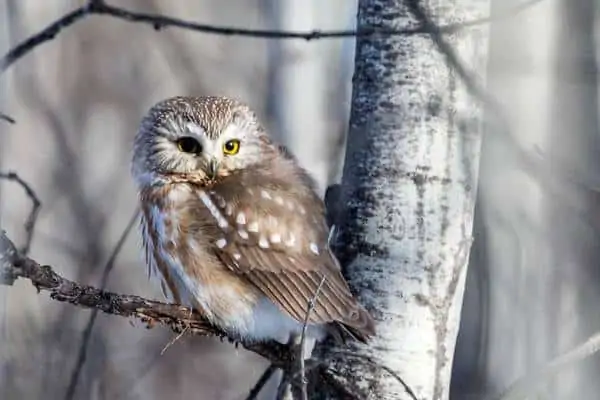
- Scientific name: Aegolius acadicus
- Length: 7.1-8.3 inches
- Weight: 2.3-5.3 oz
- Wingspan: 16.5-18.9 inches
The round head and yellow eyes of northern saw-whet owls are small. There are a few additional reasons why these owls are notoriously difficult to locate, in addition to their tiny size.
When they’re perched motionlessly on a branch, their mottled brown plumage blends in readily to the trees around them. Because these owls are only active at night, you won’t be able to encounter them while it’s bright outside.
Learning the call of a northern saw-whet owl and listening for it at night, especially between January and May, is the best way to find one. They are known as the “saw-whet” owl because of their unique call, which resembles a blade being sharpened on a whetstone. A series of whistled notes of the same pitch constitute their too-too-too call.
The diet of these owls is mostly made up of little mammals like mice and voles, and they prefer thick and mature woods. They can survive year-round in New Jersey’s northern half, but are mostly seen during the non-breeding months in the southern part.
7. SHORT-EARED OWL
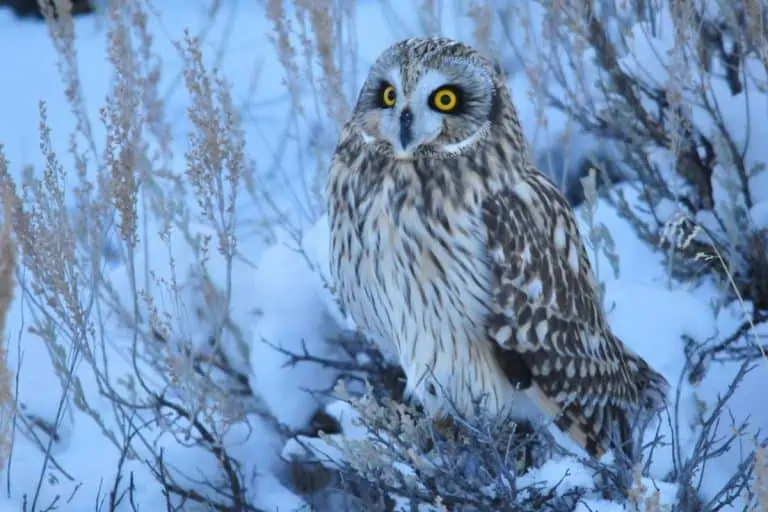
- Scientific name: Asio flammeus
- Length: 15 in
- Wingspan: 38 in
- Weight: 12 oz
Only during the non-breeding season do short-eared owls come down into New Jersey, where they spend most of their summer in Canada and northern United States.
They have “ear tuft” feathers, however they are so short that they are barely ever visible. As a result of their name, Marshes, gravel and rock quarries, fields, woodlots, and thickets are all good places to look for them during the winter. Their prey, such as moles, rats, rabbits, and weasels, may influence their populations in a given region each year.
They are vulnerable to habitat destruction and fragmentation from the enormous open grasslands they need, which is why it is assumed that their populations are declining overall.
They may be found all around the globe and may travel considerable distances across open water.
8. SNOWY OWL

- Scientific name: Bubo scandiacus
- Length: 20.5-27.9 inches
- Weight: 56.4-104.1 oz
- Wingspan: 49.6-57.1 inches
The wintering range of snowy owls extends across much of Canada, although they are increasingly going farther south into the United States each year. At least a few can be seen each year throughout the winter in New Jersey. Year to year, the quantity might fluctuate dramatically.
During the summer, these magnificent owls go north to Canada’s and Greenland’s Arctic territories to breed. During all hours of the day, they’ll be hunting lemmings, their favorite summer food.
Because of their bright white plumage, snowy owls are easier to see than other owls if they are near you. They are diurnal, like most other owls, and are thus active during the day. They like hunting in open areas, such as fields and beaches. In fact, in New Jersey’s coastal regions, they’re most likely to be found. Look for them on the beach, perched in the open, or on the ground during a snowy day.
Snowy owls are known to roam around after they reach adulthood. Hundreds of miles away from each other, owls from the same nest were discovered in opposite directions after being tracked.
